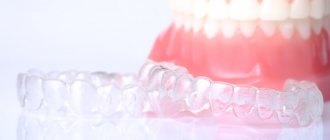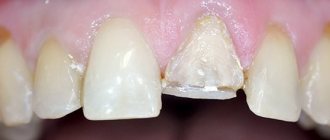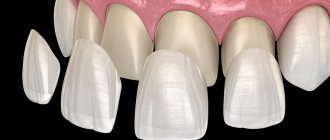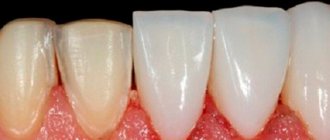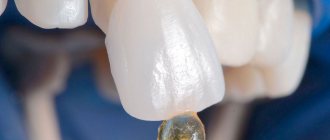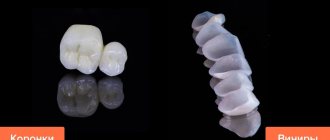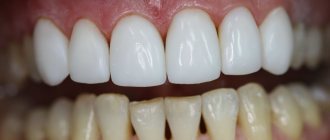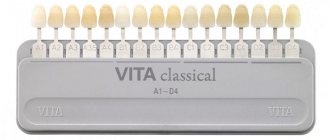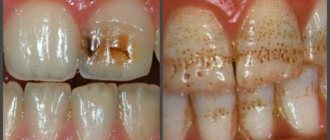From this article you will learn:
- pros and cons of composite veneers,
- cost of 1 veneer for 2021,
- Composite veneers and ceramic – what is the difference.
Composite veneers are an inexpensive alternative to ceramic veneers, and in this case, the front surface of the teeth will be covered with the most common composite filling material, from which light-curing fillings are made in dentistry. In most cases, composite veneers are made using the direct method – right in the dental chair (immediately in the patient’s mouth), without any impression taking. You only need 1 visit to the dentist.
In fact, it will be an ordinary filling, but made in the form of lining the front surface of the tooth. The undoubted advantages of such veneers are: 1) low price, 2) the ability to obtain acceptable aesthetics in just 1 visit to the dentist, 3) the ability in some situations to do without grinding off the tooth enamel, 4) the ability to quickly remove such a veneer or replace it with a new one. But in principle, this is where the advantages of direct composite veneers end, and a long list of disadvantages begins.
Composite veneers: before and after photos
However, composite veneers can be made using the indirect method, i.e. in a dental laboratory. In fact, this method completely repeats the method of making ceramic veneers (grinding the enamel, taking impressions, fixing the finished veneer) - only the veneer itself will not be made of expensive ceramic mass, but, as before, of a composite filling material. Composite veneers made in this way will not only have a longer service life and reliability, but also a higher price.
The third option for composite veneers is ready-made sets of veneers in several shades and sizes. Such veneers will also be made in a dental laboratory, but... they will not be made specifically for your teeth - before fixing them, the doctor will adapt them to your teeth (i.e., he will be forced to file here, file there). An example of such a product is “DIRECT VENEERs”, produced by the Austrian company.
A few words in defense of direct composite veneers -
Despite the fact that ordinary direct composite veneers are clearly inferior in aesthetics to ceramic veneers, they can still be made quite beautiful and also invisible against the background of neighboring teeth. The problem is that here you need to make not an ordinary filling, but give the teeth a new beautiful shape (at the same time natural), and also achieve, using a combination of layers of different shades of filling material, an imitation of the color and transparency of natural tooth enamel.
From experience I can say that approximately only 1 dentist out of 100 has good skills in artistic dental restoration. In other words: making a filling is a craft, but making veneers on the front teeth is an art, accessible to a rare dentist. Therefore, the before and after photos of composite veneers that we published above are most likely an exception, and in an ordinary average dental clinic their aesthetics will be much more modest.
Veneers: disadvantages and advantages
Veneers are used to restore the outer surface of tooth enamel. They differ from artificial crowns:
- partial closure of the tooth surface (crowns are a “cap” that covers the tooth, including from the sides);
- To install veneers, the enamel is partially ground off (it is enough to remove a layer 0.5-1 mm thick)
- used only for the restoration of front teeth (incisors, canines, less often premolars), which are visible when smiling or talking.
The common advantage of all veneers is the achievement of a good aesthetic result with the least traumatic effect on the tooth. The main disadvantages include the fact that veneers cannot solve all aesthetic problems. Other pros and cons depend on the type of veneers and the materials from which they are made.
The main disadvantages and advantages of different types of veneers
| Type of veneers | pros | Minuses |
| Removable | They cost less than any professionally manufactured microprostheses, are purchased ready-made, and do not require the participation of a dentist. | Not suitable for long-term wear. Very low aesthetic effect |
| Composite ready | Quite low cost, do not require individual production. | Fragility Poor aesthetics |
| Ceramic | Durability, best aesthetic effect. | High price. |
| Liquid | Lowest price, no need to make impressions. | Low aesthetic effect, shortest service life. |
Veneers, crowns, braces or restoration: patient reviews
The range of problems that veneers installed on human teeth help solve is quite wide. Judging by the reviews, many people had a choice regarding how to solve aesthetic problems with teeth included in the smile line. But for various reasons, in most cases they came to the conclusion that installing veneers was the most optimal option, but there were also opposite examples.
Problem of choice:
- Veneers or braces. People who naturally have defects associated with the curvature and incorrect direction of tooth growth often think about orthodontic treatment. Some of them even took it in childhood, but they were not able to completely correct their shortcomings. In this case, installing veneers helped solve the problem. An interesting review is from one of the patients who decided to install veneers on her teeth because she had complex problems (fluorosis plus “crooked teeth”). She was satisfied with the result of the installation, like most patients with wide interdental spaces.
- Veneers or restoration. There are cases when people who had their teeth restored several times eventually decided to install veneers and did not regret it. They report that the restoration does not give the desired effect, and the fillings darken over time, absorb dye from food and drinks, or begin to crumble. Installation of ceramic veneers solved dental problems in such patients for 7-10 years.
- Veneer or crown. In this situation, opinions were divided. There were people who had crowns installed, but then regretted it, because installing veneers would have been more gentle on natural teeth. But there were also people who first installed veneers, but their teeth became too sensitive or their destruction occurred. And then the person had to prepare the tooth and install a crown. But such opinions are in the minority; in most cases, the person was satisfied with the installation of veneers and wrote a positive review.
Removable veneers: pros and cons
Removable veneers are a structure that is applied to the entire dentition of the upper and lower jaw (you can purchase such an overlay only for the upper or lower teeth). These veneers are made of plastic and are placed on top of the teeth. Dental glue or silicone is used for fixation. The pads are worn as needed (at work, during a photo shoot), then removed. These products are not dental prostheses; they can be purchased (and used) independently, without consulting a doctor, for relatively little money: the price does not exceed 2000-3500 rubles. The most common among them:
- Perfect smile veneer . Made in the form of a continuous curved strip, imitating gums with teeth, which is superimposed on the front part of the jaw.
- Snap-On Smile . They resemble an orthopedic splint or mouthguard that covers both the outer and inner surfaces of the teeth (without gums), and is put on like a cover over the dentition. There are holes for the chewing surfaces of the lateral teeth. The design is made of thin plastic, so it creates minimal discomfort when wearing. This is a better model.
The advantages of removable veneers are much less than the disadvantages:
- they can be installed from above, without first removing the enamel layer - this is the main advantage of removable structures;
- unlike permanent microprostheses, a removable onlay masks the absence of individual teeth - another undeniable plus;
- low cost, affordable for many people.
Disadvantages of removable dental veneers:
- This design looks like natural teeth only from a distance (Perfect smile veneers also have an unnaturally bright color of the artificial “gum”);
- poor fixation - the false “jaw” can move or fly out at the most inopportune moment;
- fragility - it is better to remove the device while eating, otherwise the pad will quickly become unusable;
- can protrude lips due to additional volume;
- distort diction;
- create a feeling of discomfort;
- Wearing removable veneers for a long time during the day is harmful - the teeth in them are poorly washed with saliva, which over time leads to thinning of the enamel, and the accumulation of food under a poorly fitting veneer increases the risk of caries.
Before purchasing a removable structure, it is useful to study the comments on review sites - many models are rated by the authors as completely unsuitable for use. To avoid the progression of existing diseases of the teeth and other organs of the oral cavity, it is recommended to consult a doctor before purchasing.
Lumineers: pros and cons, patient reviews
Not many people can afford to have lumineers installed, since the cost of such structures is 30,000-100,000 rubles per unit. But those who have decided to undergo the procedure willingly share their experience on social networks and on the websites of dental clinics.
Save up to 70% when installing lumineers!
Let's look at the main points that patients mention in their reviews:
- Reasons for installing lumineers. People write that they agreed to have lumineers installed because this method is gentle on natural teeth. In addition, patients are attracted by the possibility of long-term wearing of veneer overlays of this type (for 10-15 years) and the high aesthetics of the structures.
- Installation process. Most people say that in order to have lumineers installed, they had to undergo a correction procedure. In this case, the teeth underwent minimal physical treatment. There are also cases where the patient agreed to have the natural teeth reshaped and “trimmed” before installing lumineers because they were too long or asymmetrical. But such a procedure is not mandatory; it is used as a way to give a person’s smile impeccable aesthetics.
- Deadlines. Lumineers take longer to complete than other veneers. In some cases, people had to wait more than a month, but in the end they were all satisfied with the final result of the installation of veneers.
- Aesthetics. Opinions about the aesthetic properties of lumineers are extremely positive: patients are satisfied with their new snow-white “Hollywood smile”. Some of them noted a slight increase in the thickness and size of the teeth, but this did not become a reason for frustration for the person, and he still left a positive review.
- Strength. Almost every review here is positive, but it would be incorrect not to mention the troubles that happened to patients who had veneers installed. In a number of cases, the veneer structure chipped or collapsed, sometimes for no apparent reason. In dental clinics, people were replaced with new structures free of charge if the collapse occurred during the warranty period for the lumineers.
- Durability. Speaking about the period of wearing lumineer overlays, in 90% of cases people wear them for more than ten years. But there are also those lucky people who manage to wear Lumineers without replacement or correction for more than fifteen years.
After analyzing information and reviews from real patients about ultra-thin veneers, we came to the conclusion that lumineers in most cases are worth the investment in them and are a worthy way to correct defects in human teeth along the smile line.
And in cases where veneers chipped and collapsed, mistakes were made during their manufacture and installation. Therefore, you should take seriously the choice of a dental clinic and the attending physician who will perform the procedure of fixing lumineers on your teeth.
No matter how durable dental veneers are, you should not forget that the habit of biting your nails, cracking nuts with your teeth and opening bottles can lead to chipping of the veneer structure and its premature wear. And in this case the patient himself will be to blame.
There are also a number of contraindications to the installation of lumineers, which a person should not neglect. For example, lumineers cannot be installed on teeth that are heavily stained (fluorosis), since veneer overlays of this type are transparent and will not be able to completely hide the desired defect.
Composite veneers: pros and cons
Composite veneers (componeers) are a relatively new material for aesthetic restoration, which has appeared in dental practice since 2011. Ready-made half-crowns are produced en masse, of standard sizes (not according to individual impressions), from a semi-liquid polymer material, similar to modern fillings, which hardens under the influence of light and temperature. The doctor installs ready-made pads, grinding them to size directly during the appointment.
Componer advantages:
- compared to liquid composite veneers - greater strength (10 years or more - there is no exact data yet, since they began to be used recently) and a more natural appearance; due to the smoother surface, frequent polishing is not required;
- compared to ceramic half-crowns - quick installation and affordable price (from 15,000 rubles per tooth).
- suitable for restoring several teeth;
- Available in a wide range of colors and various shapes;
- easily repaired directly in the patient's mouth using liquid composite polymer.
Minuses:
- susceptibility to scratches and chips;
- the ability to quickly stain from food and drinks;
- less beautiful appearance than ceramic veneers.
Componeers are a good economical alternative to expensive ceramic veneers.
Why are veneers so expensive?
For the average resident of Russia, veneers are quite expensive. According to prices, composite veneers are at the lower level, followed by ceramic ones.
A rough comparison of prices per unit would look something like this:
| Composite | Ceramic |
| 3-5 thousand rubles. | from 20 thousand rubles. |
The low cost of a composite veneer is explained by the fact that a filling material is actually applied to the tooth, which sets under an ultraviolet lamp. The doctor shapes the surface of the tooth at the first visit, immediately after grinding down the enamel.
To make ceramic veneers, other conditions are required - taking an impression, three-dimensional modeling, manufacturing on machines in automatic mode in accordance with the specified parameters. That is, fundamentally different materials (ceramics) and equipment are used here. Accordingly, the cost of the product will be higher - and the result will be better.
Important.
If you need to install veneers, then try to find an opportunity to install a non-composite option.
Ceramic veneers: pros and cons
Ceramic veneers are the best option for restoring the surface of the front teeth. They are made in a dental laboratory using individual impressions. It is best to restore not just one tooth with such crowns, but two to eight at once. Their advantages include:
- the most natural and beautiful appearance of teeth due to the fluorescent surface, the ability to give the material any shade that matches your own enamel;
- smoothness, ensuring easy care and good hygiene (there is less plaque accumulation on the ceramic surface);
- hypoallergenic;
- high resistance to staining;
- low abrasion;
- strength and durability – ceramic veneers last up to 20 years.
Disadvantages of ceramic veneers:
- the highest cost compared to onlays made from other materials (the price of one half-crown ranges from 30,000 rubles);
- long process of dental restoration;
- difficulty in repairing – it is very difficult to achieve a good effect when chipping such a veneer; They need to be removed for repairs.
Depending on the base material, ceramic veneers are divided into:
- Porcelain . They are made by hand from porcelain with various additives by casting or pressing. Porcelain plates can be slightly translucent, due to which the shade of the restored teeth does not differ from the color of neighboring healthy ones. The thinnest (and most expensive) type of porcelain veneers are laminiers, popular among Hollywood film actors.
- Zirconium dioxide . These veneers are made in an automated way (using robotic CAD/CAM equipment) - they are cut out from a single block. Most often, the base of a half-crown is made from zirconium dioxide, which is covered with another type of ceramic on top. These are the most durable and light-proof overlays, practically not susceptible to chipping. They are suitable for the most difficult cases, when the diseased tooth has darkened to such an extent that when viewed through the ceramic, it is very different in color from healthy ones. All-zirconium plates made using Prettau technology are successfully used in dental restoration in patients with bruxism.
Differences between E-max and other models
E-max models differ from conventional veneers in that they are as gentle as possible on the tooth surface. They are very thin and can be compared to Lumineers. But, thanks to the source material - strong pressed ceramics, they are very durable. They are attached to the tooth with a safe compound, fixed with the light of a special lamp.
Of course, you shouldn't crack nuts, but E-max is much more durable than other analogues. There are no microcracks when installed on defective teeth. It is guaranteed that bacteria will not get under them. No extensive enamel processing is required. The risk of chipping is minimal.
To create them, durable reinforced glass ceramics (pressed leucide) are used. They are made only taking into account the anatomical features of each person.
The shape of everyone’s teeth is different; veneers make your smile beautiful, but not toy-like. Therefore, individual proportions and crown sizes are observed.
Liquid veneers: pros and cons
As in the manufacture of composites, a composite material is used for restoration with liquid veneers. The only difference is the prosthetic technology: the composition is applied directly to the prepared tooth, bypassing the stage of manufacturing the onlays. It is advisable to restore no more than one or two teeth with liquid veneers.
Advantages of liquid veneers:
- relatively low cost (from 15,000 rubles per tooth);
- quick installation;
- ease of repair;
- the ability to restore sufficiently large damage to the dental crown.
Flaws:
- poor resistance to mechanical stress - easily chipped, scratched, requires regular professional polishing;
- not very durable - service life is no more than 5 years (on average 2-3 years);
- easily stained when eating fruits, berries, strong tea, coffee, or smoking;
- Suitable for restoring teeth with minor enamel damage.
average cost
The cost of installing composite veneers in different cities of Russia may vary. The price of a service within the same locality, but provided by different dental clinics, will also vary. The difference in cost is determined by many reasons:
- clinic level;
- volume of preliminary work;
- use of anesthesia or refusal of it;
- choosing the installation method;
- materials used, etc.
The minimum price for the entire procedure in Moscow is about 3,000 rubles, while the maximum cost can be 5 times higher.
To correctly calculate the necessary funds, you should familiarize yourself with the price list for services in advance. Such information is always available on the websites of clinics and dental centers.
Benefits and harms of veneers
Installing veneers entails both benefits and certain harms. The benefits are:
- an impeccable smile is a guarantee of self-confidence and promotes success both in your career and on the personal front;
- in reliable protection of the closed surface from mechanical, temperature, chemical influences, caries.
Harmful points:
- the ground surface of a tooth without veneers is defenseless against adverse effects and has an unsightly appearance - after the first installation, they will have to be replaced with new ones (except ceramic ones) as they become unusable throughout life.
Before installing veneers, it is useful to weigh all the pros and cons, and ask yourself whether it is worth prosthetics for healthy, albeit not entirely ideal, teeth for the sake of the fashion for a snow-white smile.
Contraindications and restrictions
There are a number of contraindications for installing veneers, based on the condition of the teeth and depending on the patient’s lifestyle. Do not neglect the doctor’s opinion and insist on your own if the specialist does not recommend installing pads.
Contraindications include:
- malocclusion, pathological tooth wear;
- lack of chewing teeth;
- bruxism – teeth grinding at night;
- presence of filled front teeth;
- large fillings on the inside of the tooth;
- practicing hazardous sports.
Limiting factors also include oral diseases and weakened teeth.
Important!
If one of the teeth has been broken at least half, there is no point in putting a veneer on it - at the first significant load it may become unusable.
How to place veneers
The prosthetic process depends on which veneers are chosen - direct or indirect. The first includes liquid veneers made of composite material, the second includes all others.
Installation of direct veneers
Installation of liquid veneers consists of the following steps:
- Initial appointment with the dentist (assessment of the condition of the oral cavity, identification of indications for a particular type of veneers and contraindications for their installation, agreement with the patient on the cost of the work).
- Grinding off 0.3-0.5 mm of enamel from the outer surface of the tooth. Without this, its shape when the veneer is installed will be convex and the color unnatural. This procedure is usually not painful, but can be performed under local anesthesia if the patient wishes.
- Layer-by-layer application of material to each prepared tooth, grinding, polishing.
The entire process can be completed in one session. Before installing veneers, failed fillings are removed and caries and its complications are treated. After dental restoration, the doctor gives recommendations on how to care for the veneers so that they last and remain in good condition for as long as possible.
Installation of indirect veneers
Stages of prosthetics with indirect veneers:
- Determination of indications and contraindications, discussion of the pricing issue with the client.
- Taking impressions for making veneers.
- Grinding the tooth surface.
- Protection of the prepared tooth. This stage is necessary to protect the damaged surface from adverse effects, normal food intake, preserve the gingival contour, and prevent displacement. For this purpose, the machined surface is sealed with a special compound - a desensitizer. A temporary filling is used to close a large defect.
- Manufacturing of veneers. It takes from one day depending on the type.
- Installation of veneers. The doctor fixes the microprostheses using special glue. Additional minor sanding may be required to ensure a better fit. After installation, the onlays are carefully ground and polished to maintain a normal bite and prevent soft tissue injury from sharp edges.
Indirect veneers are installed in 2-3 visits. The exception is compositors that do not require individual manufacturing - they can be installed in one visit.
Types of ceramic veneers
At the moment, there are two types of ceramic veneers - from pressed ceramics and from ceramics made using a refractor. Essentially they have no differences, but they are installed and processed differently. Let's look at how ceramic veneers are made:
Pressed ceramic veneers
This method of making veneers involves first making a wax model, on the basis of which ceramics are pressed under high pressure. This allows you to very accurately convey all the features of the appearance of the patient’s tooth enamel and make the inside of the veneer exactly adjacent to the tooth.
Veneers made using a refractor
When manufacturing using a refractor, a special refractory base is first made, onto which ceramics are applied in layers, and then this structure is baked in a special oven.
IMPORTANT:
Specialists at the German Implantology Center can produce ceramic veneers of any type. Any veneers are made individually for each patient, and the quality of their installation meets the highest standards.
Indications for installation of veneers
Situations when veneers give good results:
- discoloration of teeth that cannot be corrected by modern whitening methods (age-related changes, pigment spots, fluorosis)
- some changes in the shape of the teeth (chips, wedge-shaped or spiky teeth);
- disorders of the enamel - congenital underdevelopment, tendency to wear away, cracks;
- weakly expressed inclinations and rotations of teeth;
- presence of gaps between teeth;
- gummy smile (veneer allows you to make the dental crown higher);
- incomplete tooth eruption;
- the presence of small darkened fillings.
Can I use dental floss?
There are no clear prohibitions on the use of dental floss and interdental brushes, but you need to be extremely careful when using them. After prosthetics, microgaps between teeth are naturally preserved. But here it is very important not to move the thread from the gums to the edges (i.e., not to make vertical movements) - of course, not immediately, but gradually due to such actions the lining can be damaged. If you want to use floss, insert the tip not from below (from the cutting surface), but directly into the area between the teeth in the gum area - into the largest gap. After cleaning, remove it in the same way.
The same with brushes - when you remove them from the interdental space, be extremely careful. Choose the thinnest brushes. And best of all, buy an irrigator. This is an excellent replacement for both dental floss and brushes.
“Pay special attention to the condition of the gums, especially where the mucous membrane comes into contact with the edge of the veneer or lumineer. Due to tissue injury, inflammation may occur, which will lead to the fact that the pads will have to be removed for treatment, or due to a violation of aesthetics. For example, if gum recession begins and the roots of the teeth become exposed.”
Dzhutova Aida Vladimirovna Implant surgeon, periodontist Work experience more than 9 years make an appointment
Do you dream of a beautiful smile? We have developed COMPLEXES of veneers for the smile area - place 4, 6 or 12 onlays at once! Save up to 30 thousand rubles and get a Hollywood smile!
sign up now
Contraindications for installing veneers
Prosthetics with veneers are not used in the following cases:
- absence of lateral teeth;
- malocclusion (except minor degrees), severe dentition disorders;
- caries, its complications (pulpitis, periodontitis), periodontitis, periodontal disease;
- acute diseases of other organs and tissues of the oral cavity;
- bruxism;
- bad habits that have a detrimental effect on the safety of microprostheses - gnawing on objects in moments of excitement or thoughtfulness, opening bottles with teeth, cracking nuts;
- destruction of most of the dental crown;
- allergies to the medications used and components in the veneers.
It is extremely harmful (and life-threatening) to install any dentures during an exacerbation of cardiovascular, renal, and pulmonary diseases. In case of a stroke or myocardial infarction, veneers can be installed only after six months.
offers patients a choice of high-quality veneers made using the most modern technologies - such onlays do not have to be changed frequently. Experienced doctors who regularly undergo training in Western clinics will provide qualified assistance in preparing for prosthetics and install the onlays as safely and painlessly as possible.
Veneers help your dreams come true!
Dreams Come True! And a snow-white smile zone has already become a reality for everyone. Cosmetic dentistry in action! An easy and effective way to achieve an ideal set of teeth is with veneers; they are installed quickly. It's easy to choose material for any budget.
Some of my advertising:
High-quality and aesthetic Emax veneers, only advanced gentle techniques, thanks to which dental restoration will take place without pain and in a comfortable environment.
The most beautiful veneers
will be made for you by me, Sergei Sergeevich Samsakov, an orthopedic dentist with more than 10 years of successful experience. What makes my veneers different from others:
What to choose
The main advantage of composite restorations over porcelain structures is their lower price and the ability to reduce the time spent on their installation. However, this advantage can no longer be called relevant today, since technologies have appeared that make it possible to install ceramic overlays in a day.
Reviews from doctors and patients indicate that veneering eliminates dental defects, but composites are less able to imitate the natural shade and structure of the enamel. The disadvantage of composite onlays is their inaccurate fit to the tooth surface, which causes the accumulation of bacterial plaque, increasing the risk of developing caries and periodontal inflammation.
The choice of veneering type depends on the number of restorations planned, the need for additional treatment and other factors.
Composite veneers are an excellent solution for the restoration of 1-2 teeth. But if there are problems in the entire frontal area, it is better to install orthopedic ceramic overlays.
